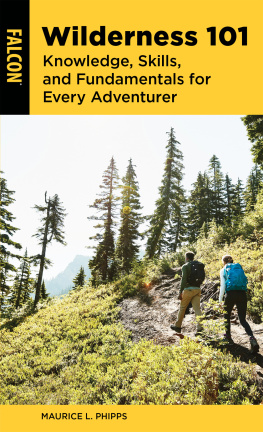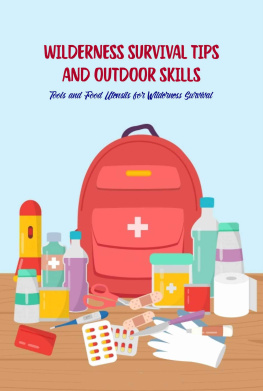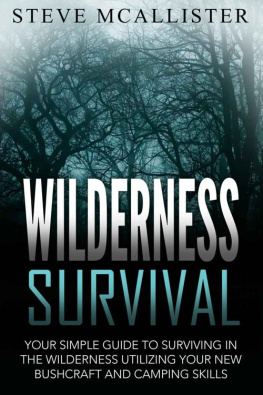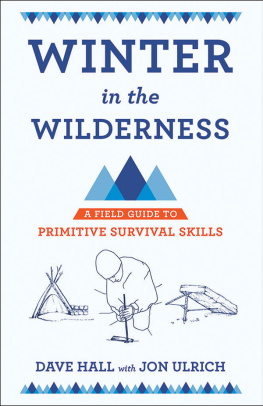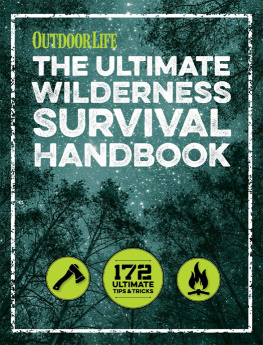About the Author
Suzanne Swedo has conducted wilderness survival, outdoor skills, and natural science outings for over thirty years as founder and director of WILD, an international and domestic adventure travel company. She has also led trips for nonprofit educational organizations, including Wilderness Institute, Pacific Wilderness Institute, Outdoor Adventures, Sierra Club, and University of California Extension. She teaches backcountry natural history seminars for the Yosemite Conservancy in Yosemite National Park, and served as survival consultant to the ten-week Warner Brothers television series Alive and Well. Her writings on survival have appeared in such publications as the Los Angeles Examiner and California magazine. She is the author of the FalconGuides Adventure Travel Tips, Best Easy Day Hikes Yosemite, Hiking Californias Golden Trout Wilderness, Hiking the Hawaiian Islands, and Hiking Yosemite National Park.
Acknowledgments
Special thanks to Ron Hood for reviewing the manuscript and for striking the spark, to Brad Childs at the Wilderness Institute, Melinda Goodwater and Singaman Lama of Goodwaters Adventures, Jim Lowery of Earth Skills, and Steve Tabor of Desert Survivors. I appreciate help from the National Outings Program of the Sierra Club and to the organizers of the Angeles Chapter of the Basic Mountaineering Training and Wilderness Training Course. Thanks to Kylie Chappell at the Yosemite Conservancy. For assistance in the field, special thanks to John Alder-son, Betty Berenson, Craig Deutsche, Laura Lathrop, Fumiaki Nakamura, and Rex Raymer.
Appendix: Checklists
Here are a few important checklists that will help you in trip planning.
FIRST AID
When heading out into the wild, you should take with you a first-aid kid. Be sure yours contains at least the following:
adhesive bandages
moleskin or duct tape
various sterile gauze and dressings
white surgical tape
an Ace bandage
an antihistamine
aspirin
Betadine solution
a first-aid book
antacid tablets
tweezers
scissors
antibacterial wipe
triple-antibiotic ointment
plastic gloves
sterile cotton tip applicators
thermometer
SAM splint
ESSENTIAL GEAR FOR DAY AND OVERNIGHT TRIPS
Day Hikes
bear repellent spray (if hiking in grizzly country)
camera
compass/GPS unit
pedometer
daypack
first-aid kit
food
guidebook
headlamp/flashlight with extra batteries and bulbs
hat
insect repellent
knife/multipurpose tool
map
matches in waterproof container and fire starter
fleece jacket
rain gear
space blanket
sunglasses
sunscreen
swimsuit and/or fishing gear (if hiking to a lake)
watch
water
water bottles/water hydration system
Overnight Trip
backpack and waterproof rain cover
backpackers trowel
bandanna
bear repellent spray (if hiking in grizzly country)
biodegradable soap
collapsible water container (23 gallon capacity)
clothingextra wool socks, shirt and shorts
cook set/utensils
ditty bags to store gear
extra plastic resealable bags
gaiters
garbage bag
ground cloth
journal/pen
nylon rope to hang food or bear-proof canister (required by law in some places)
long underwear
permit (if required)
rain jacket and pants
sandals to wear around camp and to ford streams
sleeping bag
waterproof stuff sack
sleeping pad
small bath towel
stove and fuel
tent
toiletry items
water filter
whistle
Before You Go
PORTRAIT OF A SURVIVOR
The most important characteristic shared by survivors of wilderness emergencies is a positive attitude. Almost invariably, people who come through harrowing experiences unscathed are those who believe they will. They are the people who see an emergency as a problem to solve, a challenge to overcome, who never even consider the possibility of failure.
People survived and flourished for about two million years before modern civilization, and each of us still possesses that most effective and versatile of survival toolsa human brain. If you can overcome the mindless panic that sometimes rears up in scary situations and gets in the way of your common sense, your chances of finding a way out of danger increase enormously.
In addition to the possession of a can do attitude, those most likely to overcome dangers to life and limb are people with a strong sense of personal responsibility. The wilderness is neither benevolent nor hostile; it really doesnt care one way or the other about you. It is up to you to take care of yourself, plan carefully, equip yourself properly, be physically fit, know basic first aid, and accept the consequences of your actions. Do not set off into the wilderness alone. Two people are the minimum, but the ideal number for a traveling group is four. In case of illness or injury, one person can remain with the victim while the other two go for help. If you are inexperienced, first seek experienced companions, join a group, take a class, and do some reading.
When faced with some potential disaster, stop, calm down, and think.
Assess your physical condition honestly. Do you do any kind of vigorous, regular (at least three times weekly) aerobic activity? Nature favors the strong. You dont need to be an athlete, but you should be fit and healthy. Walking on level ground in city or suburbs bears almost no resemblance to negotiating rocky, sandy, muddy, steeply ascending or descending wild country. Try a few full-day hikes over varied terrain, then a weekend outing or two before tackling a weeklong expedition.
Investigate carefully the full range of conditions you might encounter in an area during the time of year you plan to visit, and choose equipment accordingly. Remember that the finest and most expensive gear in the world cant insure you against errors in judgment or lack of knowledge. On the other hand, do not practice false economy on items that ensure your safety and comfort, such as tents and sleeping bags. If you cannot afford to buy good equipment, you probably can rent it in your hometown or in cities and towns near popular wilderness areas. Consult wilderness veterans about gear, check out reliable online sources, study magazines and catalogs, and shop at reputable wilderness outfitters whose salespeople use the equipment themselves.
Test equipment at home first: Fire up your stove; pitch your tent in the backyard. Dont get caught in the dark in a howling storm trying to make sense of yards of flapping nylon, miles of tangled tent cord, and an impossible number of poles poking out in a dozen different directions.
Pretrip Checklist
Leave word, preferably in writing, with someone at home about your planned itinerary and time of return.
Check weather forecasts for the area you plan to visit. High mountains create their own local weather, and conditions that could affect you might not show up on the national satellite weather map, television, online, or in the newspaper. Be careful not to get caught at high altitude in a bad storm or along a stream in a flash flood. For more information see the Falcon-Guide Reading Weather by Jim Woodmencey.
Find out whom to contact at the nearest trailhead in case of emergency. In national parks it will be the National Park Service, but in other areas the sheriffs office is your best bet. Make a mental note of the location of phone service nearest the trailhead.


